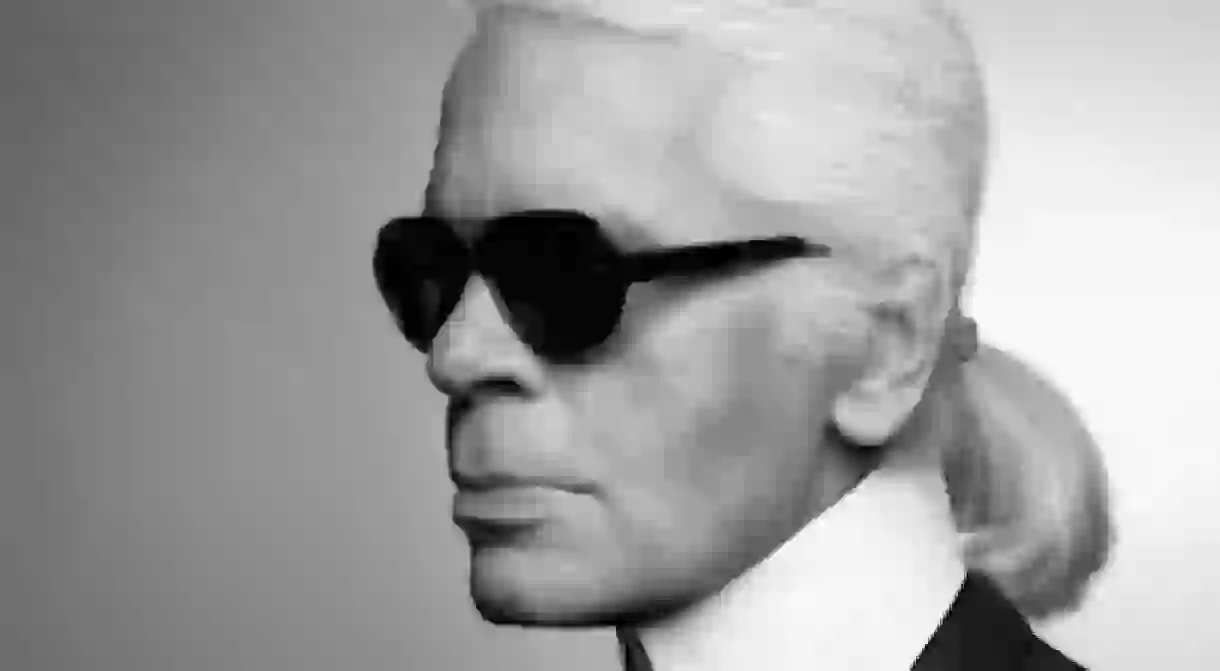Karl Lagerfeld: Images From A Visionary Career

Creative director at Chanel and Fendi, Karl Lagerfeld’s influence on the fashion world is both expansive and unparalleled. With his unrelenting work ethic and industry expertise, Lagerfeld continues to be one of fashion’s most esteemed and intriguing figures. Follow us through the Pinacothèque de Paris‘ must-see exhibition, Karl Lagerfeld, A Visual Journey, which commemorates the designer’s photographic career.

A shock-white ponytail, perpetual sunglasses, bejeweled fingers and staple black suit, Karl Lagerfeld — fashion’s most important figure — cuts an instantly recognizable silhouette. During his long and diverse career, he has led the world’s largest and illustrious fashion houses to success.
After winning the International Wool Secretariat Prize in 1954, along with future fashion legend Yves Saint Laurent, Lagerfeld’s career began as Balmain’s apprentice. His CV includes Chloé, where he began working in 1966, and Italian brand Fendi, where he is still creative director. Lagerfeld recently celebrated his 50th anniversary with the house — the longest collaboration between a designer and fashion label to date. Add to that his own label and collaborations with H&M, Coca-Cola, and Diesel, Lagerfeld is constantly creating.

Undoubtedly, his most significant role is as head designer at Chanel, continuing Coco Chanel’s legacy by upholding the brand’s signature elements whilst reinventing it for a modern audience. The year 1982 marked his first haute couture collection for the French house, which has since become a biannual media extravaganza. The recent 2015/16 fall show took on a casino theme, filled with Chanel’s celebrity muses from Inès de La Fressange and Amanda Harlech to Kristen Stewart and Lily-Rose Depp.
Lagerfeld’s ability to anticipate, and in many ways, dictate fashion’s fragile zeitgeist is what keeps him at the top of the industry. Now 82 years old with no intention of slowing down, he views this unquenchable thirst as an essential part of the creative process: ‘You must not stand still, not in life, not in fashion and not in photography.’
Picking up photography almost by chance in 1987 when Eric Pfrunder, Director of Image at Chanel, urgently needed press images, Lagerfeld’s relationship with the camera quickly flourished. He says: ‘Today photography is part of my life. It completes the circle between my artistic and professional restlessness.’
Karl Lagerfeld, A Visual Journey is dedicated to the designer’s photographic career and his unique interpretation of beauty, architecture, nature, fashion photography and antiquity. The exhibition includes different printing techniques — daguerreotypes, platinotypes, Polaroid transfers, resinotypes, Fresson prints, screen-prints and digital prints — highlighting Lagerfeld’s dexterity with both composition and perspective.
Opening images of Chanel favorites Diane Kruger, Lou Douillon and Carla Bruni are silkscreen transfers on Arches paper, giving a mesmerizing bobble effect. His creative flexibility is seen again in ‘The Portrait of Dorian Gray,’ where portraits of Larry Scott and Eva Herzigová as Mr. and Mrs. Gray are digitally aged to project the transient nature of beauty.

Beauty is a recurrent theme throughout the works. The two large installations — ‘Daphnis et Chloé’ and ‘Le Voyage d’Ulysse’ — represent Lagerfeld’s contemporary perception of antiquity.
The only known work by Greek novelist Longus, Daphnis and Chloe is a pastoral love story, considered more modern in subject when compared with its Greek contemporaries. In this visual interpretation of the novel, toga-clad, Herculean models are captured in an idyllic woodland scene.

A quote by French writer Hippolyte Taine is mounted in-between the works — ‘L’antiquité est la jeunesse du monde’ (‘Antiquity is the youth of the world’) — reinforcing the simplistic beauty featured in the photos.
‘Body Freedom,’ a series of black and white nudes, echoes the natural elegance of ‘Daphnis et Chloé.’ Lagerfeld also draws our attention to androgyny, particularly felt in the portrait of Giabiconi and Freja Beha Erichsen.

Following from this is ‘Le Voyage d’Ulysse,’ a floor-to-ceiling interpretation of Homer’s Odyssey. The acrylic canvas print makes the images white out while walking away, literally fading into the past.
This ghoulish silhouette is immediately contrasted with the new as the exhibition leaps into Lagerfeld’s work for contemporary fashion magazines. From lavish black and white portraits of Candice Swanepoel in swirling chiffon and pearls to Saskia de Brauw playing la Parisienne in quintessential French stripes to Lindsey Wixon’s modern Marie Antoinette in pastel tweed, several themes central to the Chanel-Lagerfeld relationship run through the images. Decadent costumes are incorporated and enhanced by the natural settings, each image telling a story and underlining our perceptions of elegance today.
Certain shots highlight how celebrities are cemented into the fashion world, from a nude Miley Cyrus in a wheelbarrow full of stuffed toys to model-of-the-moment Kendal Jenner posing for Harper’s Bazaar.

When viewed in comparison with the Grecian portraits, Lagerfeld emphasizes how our perceptions of beauty have changed over the years.
The exhibition’s underlying message is encapsulated in a quote by Spanish philosopher George Santayana, ‘Le corps et l’âme ne sont pas deux entités différentes mais deux manières de percevoir la même chose,’ or ‘The body and the soul are not two different entities but two ways of perceiving the same thing.’
Karl Lagerfeld, A Visual Journey is an inspiring documentation of the designer’s interests and photographic skills, as well as resounding proof of how he continues to test conceptions of fashion, beauty and luxury today.
Pinacothèque de Paris, 28 Place de la Madeleine, 75008 Paris, France, +33 1 42 68 02 01













